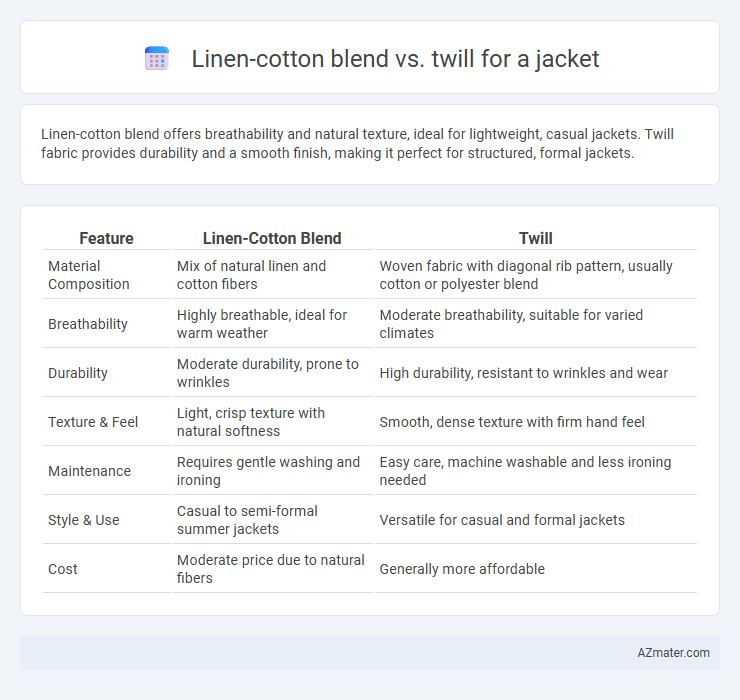Linen-cotton blend offers breathability and natural texture, ideal for lightweight, casual jackets. Twill fabric provides durability and a smooth finish, making it perfect for structured, formal jackets.
Table of Comparison
| Feature | Linen-Cotton Blend | Twill |
|---|---|---|
| Material Composition | Mix of natural linen and cotton fibers | Woven fabric with diagonal rib pattern, usually cotton or polyester blend |
| Breathability | Highly breathable, ideal for warm weather | Moderate breathability, suitable for varied climates |
| Durability | Moderate durability, prone to wrinkles | High durability, resistant to wrinkles and wear |
| Texture & Feel | Light, crisp texture with natural softness | Smooth, dense texture with firm hand feel |
| Maintenance | Requires gentle washing and ironing | Easy care, machine washable and less ironing needed |
| Style & Use | Casual to semi-formal summer jackets | Versatile for casual and formal jackets |
| Cost | Moderate price due to natural fibers | Generally more affordable |
Introduction to Linen-Cotton Blend and Twill Jackets
Linen-cotton blend jackets combine the breathability and natural texture of linen with the softness and durability of cotton, making them ideal for warm-weather wear and casual elegance. Twill jackets, characterized by their distinctive diagonal weave, offer enhanced durability and resistance to wrinkles, providing a structured and polished appearance suitable for both casual and semi-formal occasions. Choosing between linen-cotton blends and twill fabrics depends on the desired balance between comfort, texture, and fabric resilience in jacket construction.
Fabric Composition: Linen-Cotton Blend vs Twill
Linen-cotton blends combine the breathability and natural texture of linen with the softness and durability of cotton, creating lightweight, moisture-wicking fabrics ideal for warm-weather jackets. Twill fabric, characterized by its distinctive diagonal weave, offers enhanced strength, wrinkle resistance, and a smoother surface, commonly made from cotton, polyester, or wool blends. Compared to linen-cotton blends, twill provides greater durability and structure, making it well-suited for tailored jackets requiring a crisp, polished appearance.
Breathability and Comfort Comparison
Linen-cotton blends offer superior breathability and moisture-wicking properties, making them ideal for lightweight, comfortable jackets in warm weather. Twill fabric, characterized by its diagonal weave, provides durability and a smoother texture but tends to retain more heat, reducing breathability. For optimal comfort in hot climates, linen-cotton blend jackets excel, while twill jackets are better suited for cooler or transitional seasons.
Durability and Longevity of Each Fabric
Linen-cotton blend jackets offer breathable comfort and a lightweight feel but typically show more wear over time due to linen's natural fiber softness and susceptibility to creasing. Twill fabric, characterized by its distinctive diagonal weave, provides superior durability and resistance to abrasion, making it a long-lasting choice for jackets subjected to frequent use. The sturdy construction of twill ensures that jackets retain their shape and appearance longer compared to the more delicate linen-cotton blends.
Style and Aesthetic Differences
Linen-cotton blends offer a lightweight, breathable texture with a natural, slightly rustic aesthetic that enhances casual and summer jackets through visible irregular fibers and a matte finish. Twill fabric features a distinctive diagonal weave that adds durability and a smooth, polished surface, creating a sharper, more structured appearance ideal for formal or tailored jackets. The choice between these fabrics defines the jacket's style identity, with linen-cotton emphasizing relaxed elegance and twill providing classic sophistication and enhanced wrinkle resistance.
Weight and Seasonal Suitability
Linen-cotton blends are lightweight and breathable, making them ideal for warm-weather jackets due to their moisture-wicking properties and natural fibers. Twill fabric is generally heavier and more durable, offering better insulation and suitability for cooler seasons or transitional weather. Weight differences typically range from 200-350 grams per square meter (gsm) for linen-cotton blends versus 300-450 gsm for twill, influencing their respective comfort and thermal performance.
Ease of Care and Maintenance
Linen-cotton blend jackets offer moderate ease of care with machine washability and reduced wrinkling compared to pure linen, but require prompt drying and occasional ironing to maintain appearance. Twill jackets are highly durable and resist stains, allowing for less frequent washing and easy spot cleaning, which simplifies maintenance. Both fabrics benefit from cold water washing and air drying, but twill typically demands less ironing and exhibits superior wrinkle resistance, enhancing overall ease of care.
Price Comparison and Affordability
Linen-cotton blend jackets typically offer a more affordable price point, ranging from $60 to $150, due to the cost-effectiveness of natural fibers and simpler weave construction. Twill jackets, often crafted from heavier, tightly woven fabrics like cotton or wool, usually command higher prices between $100 and $250, reflecting their durability and tailored finish. For budget-conscious shoppers prioritizing comfort and breathability, linen-cotton blends present a cost-efficient option, while twill jackets provide enhanced structure and longevity at a premium cost.
Best Use Cases for Linen-Cotton Blend Jackets
Linen-cotton blend jackets are ideal for warm weather due to their lightweight breathability and moisture-wicking properties, making them perfect for spring and summer casual outings or semi-formal events. The natural fibers offer enhanced comfort and a relaxed yet polished look, suitable for daytime wear, beach weddings, and outdoor gatherings. Compared to twill, which excels in durability and structure for colder weather and workwear, linen-cotton blends prioritize comfort and ventilation without sacrificing style.
When to Choose Twill Jackets
Twill jackets are ideal for cooler weather due to their dense weave, which provides enhanced durability and resistance to wrinkles compared to linen-cotton blends. Their diagonal weave pattern offers a smooth texture and greater warmth, making them suitable for formal or business settings where structure and longevity are essential. Choose twill jackets for their classic appearance and ability to maintain shape during extended wear or outdoor activities.

Infographic: Linen-cotton blend vs Twill for Jacket
 azmater.com
azmater.com